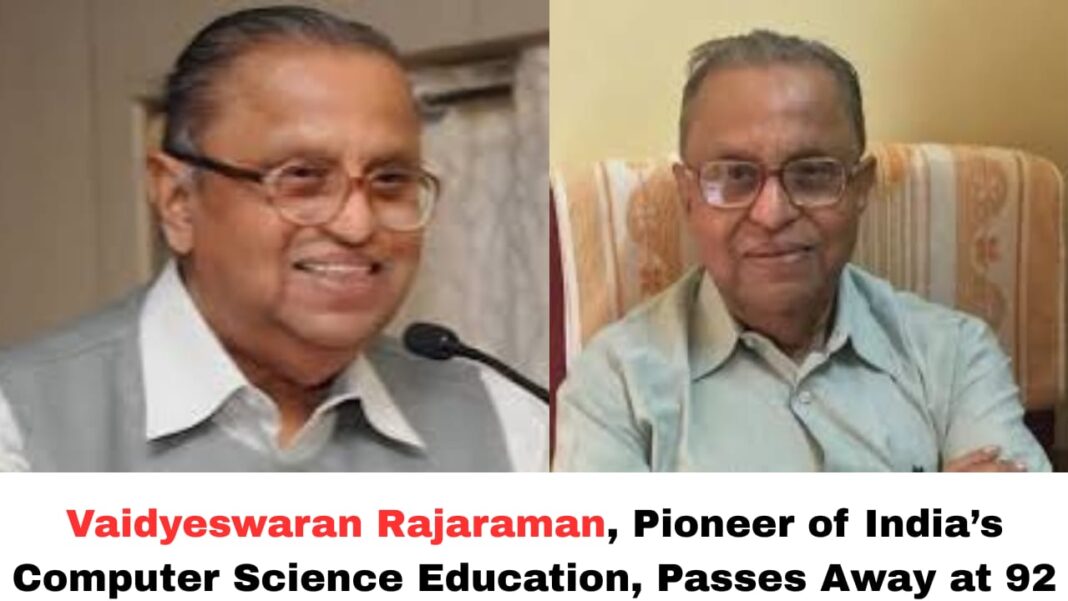Digital News Guru Lifestyle Desk:
Vaidyeswaran Rajaraman
The Indian academic and computer-science pioneer Vaidyeswaran Rajaraman passed away on 8 November 2025 at the age of 92. His death marks the end of a remarkable chapter in the history of computing education in India. Known widely as the “Pitāmaha” (grandfather) of computer science education in the country, Rajaraman’s contributions spanned teaching, curriculum-building, writing textbooks and helping set up important computing infrastructure.
Early life and academic formation
Born on 8 September 1933 in Erode, in what was then the Madras Presidency of British India, Rajaraman embarked on a journey that would shape the landscape of Indian computing. He earned a BSc (Honours) in Physics from St. Stephen’s College, Delhi in 1952, followed by a diploma in Electrical Communication Engineering from Indian Institute of Science (IISc), Bengaluru in 1955. He then went abroad, completing an MSc at Massachusetts Institute of Technology and a PhD at University of Wisconsin–Madison in 1961.

In 1962 he returned to India and joined Indian Institute of Technology Kanpur (IIT Kanpur) as an assistant professor. It was here that his major educational impact began.
Foundations of computer science education in India
Rajaraman is credited with launching India’s first formal academic programme in computer science. At IIT Kanpur in 1965 he, along with colleagues, initiated an MTech in Computer Science — the first of its kind in the country. Subsequently, a doctoral programme followed, and by 1978 a BTech in Computer Science was launched under his guidance.
This institutional and curricular architecture laid the groundwork for generations of computer-scientists and engineers in India. In his own words and in the recollections of his students, Rajaraman combined rigour with accessibility: making the nascent field of “computing” into a disciplined academic subject in India.
He also oversaw important initiatives at IISc, Bengaluru, where from 1982–94 he led efforts in low-cost parallel computing and supercomputing facility development.
Writing, mentorship and influence
Beyond institutional set-up, Rajaraman’s influence came through his textbooks (over 20), his research output and his role as mentor. His books on computer programming, numerical methods, digital logic and parallel computing became staples in Indian engineering curricula. He supervised many PhD students and is remembered for nurturing minds who went on to prominent roles in academia and industry.
The breadth of his influence is also seen in India’s broader digital and computing initiatives: from curriculum reform (for example advocating for MCA programmes) to governance of computing infrastructure.
Recognitions and honours
Rajaraman’s work was recognised with some of India’s highest honours. He was awarded the prestigious Shanti Swarup Bhatnagar Prize (for engineering science) early on, and later the civilian honour of Padma Bhushan in 1998. He was elected Fellow of multiple Indian science and engineering academies, reflecting peer acknowledgement of his sustained contribution.
Legacy and the way forward
The passing of Rajaraman is not simply the end of a life, but a marker for reflection on how far India’s computing and information-technology journey has come — and how much of it rests, in part, on the foundations he helped lay.
His legacy can be thought of in several dimensions:
- Curricular legacy: The systematic introduction of computer science programmes in engineering institutions in India enabled the growth of a skilled workforce and the subsequent explosion of the Indian software industry.
- Textbook and pedagogy legacy: His textbooks and teaching style emphasised clarity, rigour and applications — bridging the gap between theory and practice in a time when computer science was still emerging in Indian academia.
- Infrastructure and research legacy: Through his work at IISc and other institutions he fostered parallel computing and supercomputing capacity, important for advanced research and national computing capability.
- Mentorship legacy: His students, mentees and the broader academic community carry forward his ethos of blending foundational knowledge with practical relevance.
As India navigates the era of artificial intelligence, big data, cloud computing and digital governance, the importance of robust academic foundations remains paramount. Rajaraman’s life is a reminder that enduring progress in technology depends as much on teaching, curriculum-design and human development, as on gadgets and platforms.

A final tribute
In an age where tech stories often highlight startup founders, product launches and funding rounds, Rajaraman’s story offers a different lens: that of the educator-architect, the long-horizon thinker, the person who chooses to invest in generations, not just innovations. His work may not have always appeared sensational, but the ripples of his efforts are embedded in the millions of engineers, programmers and thinkers India has produced.
As his obituary titles have rightly called him — the “Pitāmaha” of computer science education — we remember his many roles: scholar, teacher, builder, mentor and institution-maker. India’s digital narrative is richer for his contribution. His passing invites us to pause, reflect and commit to carrying forward the values he stood for: clarity of thought, depth of understanding, and dedication to teaching.
In the words of one tribute:
“He defined India’s digital future by first defining how to teach the field.”
May his memory be a blessing, and may the seeds he sowed continue to flourish in classrooms, labs and the many minds of the next generations.
You May Also Read: Delhi Enters Red Zone: AQI Above 400, The Real Story Behind the Smog and AQI Surge









